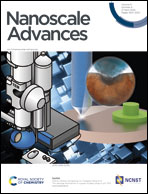Nickel and cobalt-based tungstate nanocomposites as promising electrocatalysts in alkaline direct methanol fuel cells†
Abstract
In this work, a non-precious group metal (non-PGM) electrocatalyst based on transition metals is introduced as a promising solution for enhancing the efficiency of direct methanol fuel cell (DMFC). Nickel–cobalt mixed tungstate was prepared using a simple co-precipitation method with different molar ratios of Ni, Co and W. The prepared materials were tested and validated using different characterization techniques. It was observed using SEM that the materials are agglomerated amorphous random circular nanocomposite structures. The electrochemical performance of the prepared electrocatalysts revealed that the best nanocomposite was the one with the Ni : Co : W ratio of 1 : 1 : 1.5 (W1.5). This composite showed a higher current density of 229 mA cm−2 towards methanol oxidation at a scan rate of 50 mV s−1 in 1 M methanol at 0.6 V, with the lowest onset potential of 0.33 V. The obtained results present a new strong non-PGM material for direct methanol electro-oxidation reactions and open new doors for economic and earth-abundant electrocatalysts as an alternative to expensive commercially available catalysts.



 Please wait while we load your content...
Please wait while we load your content...